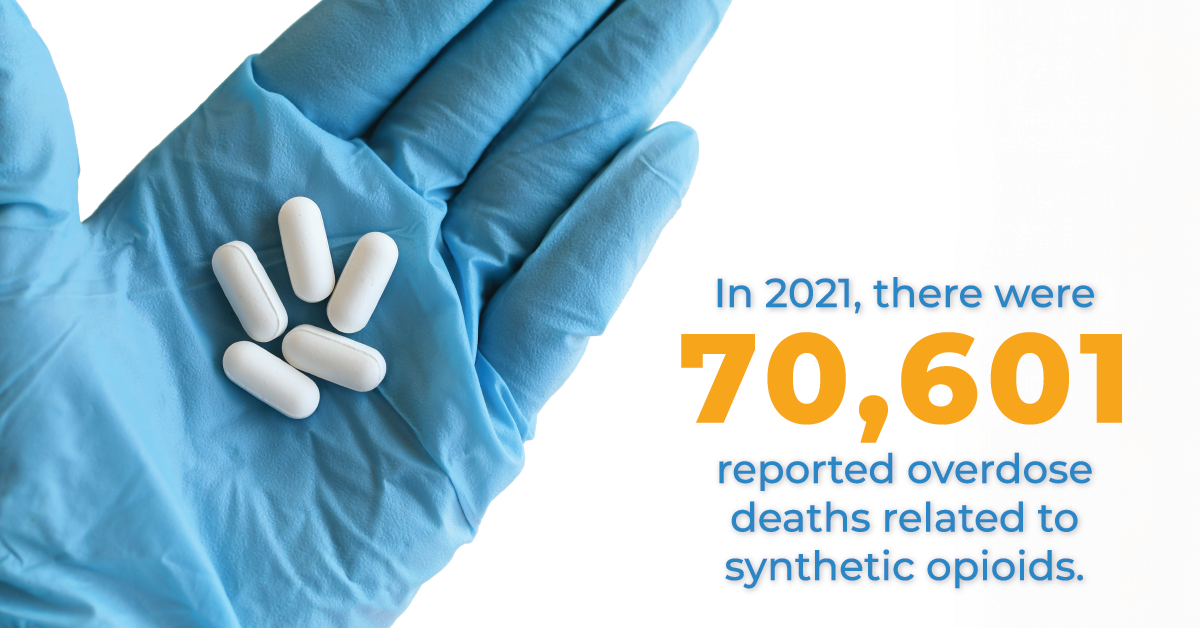Understanding Synthetic Opioids
Synthetic opioids are a class of drugs designed to mimic the effects of natural opioids like morphine. Fentanyl, a potent synthetic opioid, is a key member of this category. These substances, often prescribed for pain management, can be highly addictive, leading to opioid use disorder.
Unlike opioids derived from opium, synthetic opioids are entirely artificial. Understanding the impact of these drugs is crucial in addressing the ongoing global challenge of opioid abuse and its connections to heroin and other related issues. That highlights the need for opioid addiction treatment for secure recovery from drug addiction.
Key Takeaways
Synthetic opioids, like tramadol, are made in laboratories, imitating the effects of natural opioids such as morphine. Here’s what you need to know:
- Different types of synthetic opioids, including potent substances like fentanyl and therapeutic medications like methadone, play distinct roles in pain management and addiction treatment.
- The synthetic opioid epidemic contributes significantly to a widespread and concerning addiction problem.
- Holistic approaches combining detox, medication-assisted treatment, and prevention programs like harm reduction are essential to lower opioid overdose risks.
The Recovery Team is here to offer you addiction treatment. Call us today at (800) 817-1247.
History and Evolution of Synthetic Opioids
Synthetic opioids have a complex history intertwined with the origins of opioids derived from the opium poppy. Initially, natural opioids like morphine and heroin were prevalent, sourced directly from the opium poppy plant. However, the desire for more effective pain relief and the impact of pharmaceutical companies led to the development of synthetic opioids.
In the mid-20th century, pharmaceutical advances, often in pill form, resulted in novel synthetic opioids such as methadone. These medications aim to provide potent pain relief with reduced side effects. However, this period also witnessed the rise of highly potent synthetic opioids like fentanyl, developed for medical use but later misused recreationally.
Insights into Modern Trends
Today, synthetic opioids play a crucial role in pain management, but their misuse has led to a significant public health concern. The National Institute of Health actively studies the impact of these addictive substances on individuals and communities.
The prevalence of novel synthetic opioids continues to pose challenges. That emphasizes the need for balanced medical use and effective regulatory measures to address the evolving landscape of opioid-related issues.
Spectrum of Synthetic Opioids
Let’s explore synthetic opioids—man-made substances mimicking natural opioids. Knowing these basics is essential for discussing its use as a pain reliever and addiction with clarity and understanding.
Fentanyl
Fentanyl is a powerful synthetic opioid, originally developed for medical purposes, primarily managing severe pain, such as during surgery or for cancer patients. Its potency surpasses that of morphine and even heroin. Unfortunately, its misuse has led to a surge in overdose deaths.
Illicitly manufactured fentanyl is often mixed with other drugs, increasing its lethal potential. Law enforcement, healthcare providers, and communities grapple with the challenges posed by this exceptionally potent substance.
Methadone
Methadone, another synthetic opioid, plays a unique role in treating opioid addiction. Unlike natural opioids, it has a long duration of action, alleviating withdrawal symptoms and reducing cravings.
Methadone is administered in control settings to help individuals transition away from more harmful substances. However, its use requires careful monitoring due to the potential for dependency.
Tramadol
Tramadol, a synthetic opioid with milder effects compared to fentanyl or methadone, is commonly prescribed for moderate to moderately severe pain. It works by altering how the brain perceives and responds to pain. Tramadol’s abuse potential is lower than some other opioids, but caution is still necessary, as misuse can lead to addiction and adverse effects.
Carfentanil
Carfentanil, an analog of fentanyl, is exceptionally potent and primarily used for large animals like elephants. Its potency poses an extreme risk to human health, and even minute amounts can be fatal. Illicitly produced carfentanil has been found in the illicit drug supply, contributing to the rising concerns of opioid-related overdoses.
Each substance carries its own set of risks and considerations. That emphasizes the need for comprehensive education and proactive measures to address the struggles associated with their use and misuse.
How Synthetic Opioids Work
Synthetic opioids exert their effects on the body through intricate mechanisms, influencing both pain perception and sedation.
Pain-Relieving Effects
Synthetic opioids, like fentanyl and tramadol, bind to specific receptors in the brain called opioid receptors. By attaching to these receptors, they alter the way our brain senses and responds to pain signals. This pain-relieving action is potent, providing relief for various conditions but also contributing to their misuse in the drug market.
Sedative Effects on the Brain
In addition to pain relief, synthetic opioids can induce sedation. They affect the central nervous system, slowing down brain activity and promoting a calming effect.
However, this sedative property poses a high risk of overdose. The risk is higher when these powerful drugs are misused, whether in the context of prescription medication or illicit substances circulating as street drugs.
Understanding the chemical structure of these semi-synthetic opioids is crucial. Their powerful nature means that even slight deviations from recommended doses can lead to a high risk of overdose, highlighting the importance of cautious use and proper medical guidance.
Vital Role in Medicine and Surgical Field
Synthetic opioids, developed by pharmaceutical industries, play a crucial role in medical settings, offering relief from pain and aiding in various procedures. However, their potent nature requires careful administration to prevent unintended consequences, including the risk of respiratory depression and accidental overdoses.
Post-surgical Pain: Synthetic opioids are prescribed to manage pain following surgical procedures, providing effective relief for individuals during their recovery.
Cancer-related Pain: Patients grappling with cancer often endure severe pain, and synthetic opioids like fentanyl are employed to alleviate this distress, enhancing their overall quality of life.
Sedation in Medical Procedures: In specific medical procedures, synthetic opioids are used to induce sedation, ensuring patient comfort and facilitating the successful completion of the intervention.
Despite these medical benefits, the rise of new synthetic opioids, often encountered as white powder or synthetic heroin, underscores the importance of vigilance in their use.
Effects of the Synthetic Opioid Epidemic
The surge in synthetic opioid use has given rise to a concerning addiction epidemic, impacting people across various demographics. Understanding the associated side effects and the toll of synthetic opioid overdoses is crucial in addressing the broader challenges posed by this epidemic.
Synthetic opioids, including potent substances, can induce a range of side effects, contributing to the complexities of addiction. These side effects may include:
- Synthetic opioids can suppress the respiratory system, leading to potentially life-threatening respiratory depression.
- Individuals may experience excessive sleepiness and cognitive impairment, affecting alertness and reaction times.
- Gastrointestinal side effects, such as nausea and vomiting, are common after synthetic opioid use, impacting overall well-being.
- Opioids often result in decreased bowel movements.
- Individuals may develop a tolerance to synthetic opioids, requiring higher doses to achieve the desired effects, increasing the risk of dependence.
Prolonged use of synthetic opioids can lead to the development of substance use disorders, further intensifying the challenges faced by individuals grappling with addiction.
Staggering Rates of Overdose
The synthetic opioid epidemic has been marked by a staggering increase in opioid overdoses, leading to numerous fatalities. The potency of synthetic opioids, often encountered in small amounts resembling pharmaceutical fentanyl, significantly elevates the risk of fatal overdoses.
According to the National Institute of Health, in 2021, the number of overdose deaths involving synthetic opioids, mainly fentanyl, kept going up. There were 70,601 reported overdose deaths related to these substances.
Illicit laboratories produce new synthetic opioids, sometimes mixed with other substances like cocaine, amplifying the challenges faced by public health authorities and law enforcement.
Holistic Programs to Break Free From Addiction
A holistic approach to treating addiction is a full-circle plan that helps a person in many ways. First, there’s detox, where the body gets rid of harmful substances. That allows the person to start with a clean slate. Then, there’s medication-assisted treatment, which uses medicines to reduce cravings and make it easier to stop using drugs.
These programs also combine counseling and therapy to address the mental health of a patient. Exercise and a healthy diet under medical care improve the chance of recovery, and they further provide an aftercare program.
Harm Reduction and Prevention Strategies
Safety and prevention are all about keeping people safe and lowering the harmful effects of drugs. Harm reduction is like a safety plan that helps minimize the risks of dangerous activities. Harm reduction encourages the safe use of drugs, such as clean needle use and disposal, to reduce risks of HIV.
A nasal spray is a simple tool that can save the life of a person during a drug overdose emergency. It’s used to give medicine through the nose; one important medicine is naloxone.
It works by helping the person breathe properly again and stabilizing their condition. In essence, naloxone in a nasal spray can be a life-saving intervention during opioid emergencies.
Rise Above Addiction with The Recovery Team
The Recovery Team understands the current state of the synthetic opioid epidemic and stands with people dealing with opioid use disorder.
During opioid treatment at residential rehab, we provide medical integration to help clients stay in touch with the medical team and receive medical services. To improve the chances of recovery, we offer relapse prevention therapy in a secure setting.
Don’t hesitate to call our team at (800) 817-1247.






